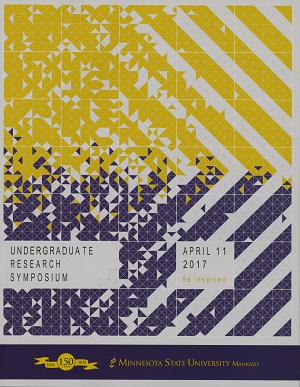Connective Tissue Infiltration into Three-Dimensional Printed Stainless Steel Alloy
Location
CSU Ballroom
Start Date
11-4-2017 10:00 AM
End Date
11-4-2017 11:30 AM
Student's Major
Biological Sciences, Automotive and Manufacturing Engineering Technology
Student's College
Science, Engineering and Technology
Mentor's Name
Michael Bentley
Mentor's Department
Biological Sciences
Mentor's College
Science, Engineering and Technology
Second Mentor's Name
Kuldeep Agarwal
Second Mentor's Department
Automotive and Manufacturing Engineering Technology
Second Mentor's College
Science, Engineering and Technology
Description
The biomaterial used in medical implantable devices must sufficiently integrate within the biological system and be compatible with surrounding tissue. Hydroxyapatite (HA), a bioactive material that is a major and essential component of normal bone and teeth, is often used for coating metal implants to initiate implantation. However, its bioactivity leads to high biodegradation when implanted alone, which can result in clinical implant failure. In the present study, our focus is on the biocompatibility of a mixture alloy of stainless steel and hydroxyapatite, fabricated by using a three-dimensional printer. To test the biocompatibility of the fabricated metal implant in vivo, one millimeter-sized lattice structure metal pieces of high and low HA ratio mixture alloys were inserted on rat skulls through a small incision on the back made using a sterilized implantation surgery. After five months, the metal pieces were removed and observed under scanning electron microscopy to determine the degree of infiltrated bone and connective tissue. The surrounding connective tissues were also examined for inflammation and other tissue damages. The result showed that, the metal alloys that were fixed on the bone were encapsulated by dense connective tissue continuous with the periosteum without having any signs of inflammation or rejection. Furthermore, connective tissue infiltrated into spaces within alloy, between and around the spheres of stainless steel, to form a dense matrix of cellular and fibrous material throughout the implant. Our findings will help improve medical device alloys for hip, femur, dental, and other implants.
Connective Tissue Infiltration into Three-Dimensional Printed Stainless Steel Alloy
CSU Ballroom
The biomaterial used in medical implantable devices must sufficiently integrate within the biological system and be compatible with surrounding tissue. Hydroxyapatite (HA), a bioactive material that is a major and essential component of normal bone and teeth, is often used for coating metal implants to initiate implantation. However, its bioactivity leads to high biodegradation when implanted alone, which can result in clinical implant failure. In the present study, our focus is on the biocompatibility of a mixture alloy of stainless steel and hydroxyapatite, fabricated by using a three-dimensional printer. To test the biocompatibility of the fabricated metal implant in vivo, one millimeter-sized lattice structure metal pieces of high and low HA ratio mixture alloys were inserted on rat skulls through a small incision on the back made using a sterilized implantation surgery. After five months, the metal pieces were removed and observed under scanning electron microscopy to determine the degree of infiltrated bone and connective tissue. The surrounding connective tissues were also examined for inflammation and other tissue damages. The result showed that, the metal alloys that were fixed on the bone were encapsulated by dense connective tissue continuous with the periosteum without having any signs of inflammation or rejection. Furthermore, connective tissue infiltrated into spaces within alloy, between and around the spheres of stainless steel, to form a dense matrix of cellular and fibrous material throughout the implant. Our findings will help improve medical device alloys for hip, femur, dental, and other implants.
Recommended Citation
Hasan, Mehedi; Clenten Ndonwie; and Bethany Haus. "Connective Tissue Infiltration into Three-Dimensional Printed Stainless Steel Alloy." Undergraduate Research Symposium, Mankato, MN, April 11, 2017.
https://cornerstone.lib.mnsu.edu/urs/2017/poster-session-A/9



